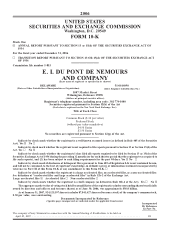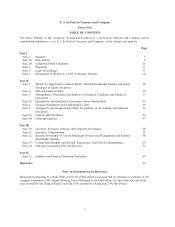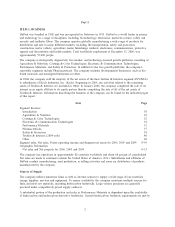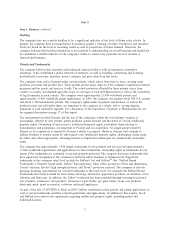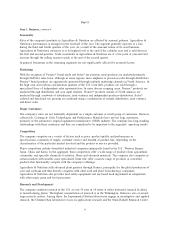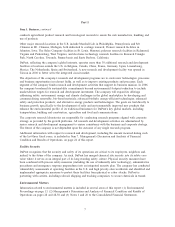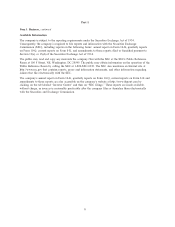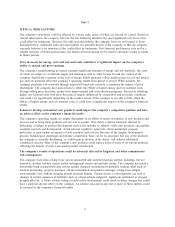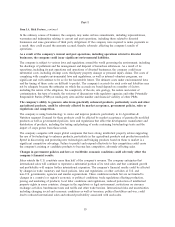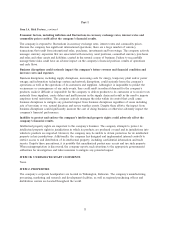DuPont 2006 Annual Report Download - page 3
Download and view the complete annual report
Please find page 3 of the 2006 DuPont annual report below. You can navigate through the pages in the report by either clicking on the pages listed below, or by using the keyword search tool below to find specific information within the annual report.Part I
ITEM 1. BUSINESS
DuPont was founded in 1802 and was incorporated in Delaware in 1915. DuPont is a world leader in science
and technology in a range of disciplines, including biotechnology, electronics, materials science, safety and
security and synthetic fibers. The company operates globally, manufacturing a wide range of products for
distribution and sale to many different markets, including the transportation, safety and protection,
construction, motor vehicle, agriculture, home furnishings, medical, electronics, communications, protective
apparel and the nutrition and health markets. Total worldwide employment at December 31, 2006, was
approximately 59,000 people.
The company is strategically aligned into five market- and technology-focused growth platforms consisting of
Agriculture & Nutrition; Coatings & Color Technologies; Electronic & Communication Technologies;
Performance Materials; and Safety & Protection. In addition to the five growth platforms, the company’s
reportable segments include Pharmaceuticals. The company includes developmental businesses, such as bio-
based materials and nonaligned businesses in Other.
In 2004, the company sold the majority of the net assets of the then Textiles & Interiors segment (INVISTA)
to subsidiaries of Koch Industries, Inc. (Koch). Beginning in 2005, any activities related to the remaining
assets of Textiles & Interiors are included in Other. In January 2006, the company completed the sale of its
interest in an equity affiliate to its equity partner thereby completing the sale of all of the net assets of
Textiles & Interiors. Information describing the business of the company can be found on the indicated pages
of this report:
Item Page
Segment Reviews
Introduction 30
Agriculture & Nutrition 30
Coatings & Color Technologies 32
Electronic & Communication Technologies 34
Performance Materials 35
Pharmaceuticals 37
Safety & Protection 38
Textiles & Interiors (2004 only) 40
Other 40
Segment sales, Net sales, Pretax operating income and Segment net assets for 2006, 2005 and 2004 F-54
Geographic Information
Net sales and Net property for 2006, 2005 and 2004 F-53
The company has operations in approximately 80 countries worldwide and about 60 percent of consolidated
Net sales are made to customers outside the United States of America (U.S.). Subsidiaries and affiliates of
DuPont conduct manufacturing, seed production, or selling activities and some are distributors of products
manufactured by the company.
Sources of Supply
The company utilizes numerous firms as well as internal sources to supply a wide range of raw materials,
energy, supplies, services and equipment. To ensure availability, the company maintains multiple sources for
fuels and most raw materials, including hydrocarbon feedstocks. Large volume purchases are generally
procured under competitively priced supply contracts.
A substantial portion of the production and sales in Performance Materials is dependent upon the availability
of hydrocarbon and hydrocarbon derivative feedstocks. Current hydrocarbon feedstock requirements are met by
3

